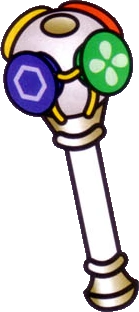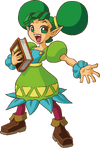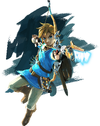- This article is about the game. For other uses, see Oracle of Seasons (Disambiguation).
The Legend of Zelda: Oracle of Seasons is one of two The Legend of Zelda titles released for the Game Boy Color, the other being Oracle of Ages, both representing the seventh and eighth main installments of the series. Released near the end of the system's lifespan, Oracle of Seasons and its counterpart were said to "send the Game Boy Color out with a bang."[9] In anticipation of the upcoming release of the Game Boy Color's successor, the Game Boy Advance, the games exhibited special features (such as the Advance Shop) when played on the new handheld system.
After completing one of the two games, they can be linked to form a single, linear plot (as opposed to two parallel ones) with an alternate ending. Game-linking also unlocks extra content, such as new items.[10] The game is named after its central character, Din, Oracle of Seasons, and the element that is manipulated by Link in the game, the four seasons.
It was released for the Nintendo 3DS Virtual Console in Japan on February 27, 2013,[3] in North America, Europe and Australia on May 30, 2013,[2][6][4] and in South Korea on April 20, 2016.[5]The game was again re-released on July 26, 2023, this time in an update for the Nintendo Switch Online.[7]
Story[]

The story is far from over...
Oracle of Seasons opens up the same as Oracle of Ages, with Link riding a horse. Spying a castle on the horizon, he goes inside and is sent by the Triforce to help a land being ravaged by the ruthless General General Onox. Link is teleported to the land of Holodrum and after a bit of exploring discovers a traveling troupe. After hanging around and dancing with the troupe's main attraction, Din, the sky becomes dark and General Onox strikes. In the ensuing chaos, Din revealed to be the Oracle of Seasons, gets kidnapped, taken to Onox's mountain fortress, and imprisoned inside of a crystal. As a result, the Temple of Seasons falls into the earth and the seasons of the land begin to become erratic.
Link embarks on a quest to save Din and restore order. The young hero learns from the Maku Tree that in order to penetrate to the center of Onox's fortress, he needs to collect eight Essences of Nature.
While in the process of visiting the dungeons, Link spies a shady character moving in the weeds. He sneaks by her and the girl disappears. After some exploration, he uncovers a strange-looking portal. Stepping on it, he is teleported to the lava-hot underground land of Subrosia. Looking to his left, he sees the missing Temple of Seasons. Taking the Rod of Seasons that he borrowed from the Temple itself, he learns seasons from the temple that become useful in his quest to retrieve the eight Essences of Nature.
After finishing the last of the dungeons and destroying Onox and his evil dragon alter-ego, Din is released and the seasons become regular once again. However, the adventure is far from over. The Flame of Destruction is already lit by the destruction Onox caused. Observing Link from afar, a mysterious pair laughs, saying the true evil had yet to arrive...
The adventure carries on in a Linked Game of Oracle of Ages (or a linked game of Seasons if Ages played first).
Gameplay[]
General Mechanics[]
Oracle of Seasons (and its counterpart, Oracle of Ages) retain many gameplay elements from Link's Awakening (especially the DX version), such as the graphics (many sprites in Oracle of Ages and Oracle of Seasons are reused from Link's Awakening), audio and top-view perspective. As in Link's Awakening, items (including the sword and shield) are assigned to the A and B buttons via an Inventory. Unlike certain games of the series, items are not assigned a specific place in the inventory. Collected Rupees, health, and the two equipped items are shown on an interface which consists of a yellow bar running across the top of the screen (similar to the one in Link's Awakening, which was located at the bottom of the screen).
Oracle of Seasons, like the great majority of Zelda games, features eight regular dungeons and a large overworld to explore in between. This is done with the help of an overworld map, which is composed of a 14 x 14 grid of squares, where each square represents a single screen. As Link explores the overworld, the "squares" that he's visited will be colored in. Link is guided by the Maku Tree, an important character in both games, who will direct Link to the next dungeon, among other things. Oracle of Seasons, like many games in The Legend of Zelda series, features a Trading Sequence.
One particular feature of Oracle of Seasons (and Oracle of Ages, for that matter) is the fact that certain choices made on the adventure will affect an outcome, later on, making for various possible scenarios in a single play-through. Among these are the animal companions that will accompany Link on his adventure (either Moosh, Dimitri, or Ricky), and the growth Bipsom. These choices affect the passwords obtained for a Linked Game (see below).
Where Oracle of Ages is said to be puzzle-based, Oracle of Seasons centers its gameplay on the action;[11] both of which are key gameplay elements in The Legend of Zelda series.
The Rod of Seasons[]
The Rod of Seasons is the central item of Oracle of Seasons. With it, Link can manipulate the four seasons, allowing him to solve various puzzles on his quest. For example, a path that may be blocked by a large deciduous tree can be bypassed in the winter when the leaves have fallen. When Link obtains the rod, he only has the power to change the season to winter. The rest of the seasons (which allow him to reach new locations in the Overworld) are acquired from the Temple of Seasons as the game progresses.
Linked Game[]
An important element of gameplay in Oracle of Ages and Oracle of Seasons is their unique ability to be linked together to form one linear plot, as opposed to two parallel ones. After one game is completed, the other can be linked to it using passwords provided by the game, or a Game Link Cable. Linked Games unlock additional content not seen in the separate games. Among the most notable changes in a Linked Game is the extended ending (the "true ending") where Twinrova and Ganon are encountered.
In a Linked Game of Oracle of Seasons, new characters appear in Holodrum. These characters will tell Link secrets in the form of passwords, which can be relayed to characters on a completed file of Oracle of Ages. By doing so, Link can obtain new items not seen in a non-linked game. The reverse occurs if Oracle of Seasons is played first and Oracle of Ages second.
Passwords obtained in a Linked Game vary depending on the choices Link made on his adventure. Therefore, passwords identify a specific play-through, assuring that Link will have the same animal partner in the Linked Game as in the completed game, among other things.
Magic Rings[]
Also, a unique feature of Oracle of Seasons and Oracle of Ages is the appearance of Magic Rings to be collected by Link on his quest. These rings, when worn, provide Link with a variety of bonuses and abilities, giving an almost RPG-like twist to the game. Some rings augment his strength and defense; others increase his swimming abilities; yet another prevents Link from sliding on frozen floors. Some, like the Cursed Ring, even decrease Link's abilities, making the game more challenging. Other rings simply change Link's appearance. A total of 64 rings can be collected throughout Oracle of Ages and Oracle of Seasons, some requiring the use of Linked Games to obtain, or even the use of a Game Boy Advance.
Gasha Seeds[]
Gasha Seeds appear exclusively in Oracle of Seasons and Oracle of Ages. They can be planted in patches of Soft Soil scattered across Holodrum (or Labrynna in Oracle of Ages). After a while, the tree will mature and Link can collect the single Gasha Nut that the tree will produce. Inside the nut, Link may find various goods, such as Rupees or Magic Rings.
Game Information[]
Development[]
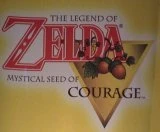
The cancelled Mystical Seed of Courage logo
Oracle of Seasons, along with Oracle of Ages were designed by Capcom, which later went on to develop two more titles for The Legend of Zelda series on the Game Boy Advance (Four Swords and The Minish Cap).
It began when Capcom game director Yoshiki Okamoto approached Nintendo producer Shigeru Miyamoto with a proposal to remake the original The Legend of Zelda for the Game Boy Color.[12] Depending on the success of this first title, Capcom would go on to develop a "more ambitious" sequel, which would be a completely new and original Zelda title built from the ground up. However, the members of the development team disagreed with Okamoto's agenda. The team wanted to skip the remake and begin creating a new Zelda title right away.[13] Thus, they began by having Capcom subsidiary Flagship write a scenario (i.e. story and characters) for the new game.[14] Prioritizing scenario over gameplay caused development difficulties early on.[15] The team was further hindered by the Game Boy Color's narrower screen. Rooms could not be fully viewed all at once, potentially causing players to overlook certain elements inside them.[16] As the project was floundering, Okamoto and the team sought Miyamoto's guidance.[17]
Miyamoto proposed the creation of the "Triforce Series", a trilogy, to supersede the current projects.[18] Each title was to focus on a different gameplay element, each relating to one of the three powers of the Triforce (i.e., Wisdom, Power, and Courage). What was originally meant to be the remake of The Legend of Zelda became the Chapter of Power (later known as Mystical Seed of Power), which was action-based.[19][20] The Tale of Power was demonstrated at the Nintendo Space World trade show in 1999; it was the only title of the three to be presented. The demo of the game had Princess Zelda, keeper of the seasons, captured by Ganon, who stole the Rod of Seasons to throw the four seasons of Hyrule into disarray while sending Hyrule Castle and the rod to another realm - a precursor to the plot of Oracle of Seasons.[21] In the demo, Link uses the Rod of Seasons to manipulate the seasons of winter, spring, summer, and autumn in order to solve puzzles.[22] Several characters of Oracle of Seasons also make an appearance, such as the "Mystery Tree" (Maku Tree), "Rikki" (Ricky), "Mable" (Maple), and the "Ulra Tribe" (Subrosians).[23]
The three games of the series would interact with each other for additional gameplay via game-linking system. However, the overcomplexity of coordinating the three games caused the cancellation of Mystical Seed of Courage. Thus the series was reduced to two titles: Oracle of Ages was adapted from Mystical Seed of Wisdom and Oracle of Seasons was adapted from Mystical Seed of Power.[24]
Through Oracle of Seasons's tumultuous development, certain elements of the game hearken back to its days as a remake of the original NES title. Such elements include Gnarled Root Dungeon, several recurring bosses, and the prevalence of Old Men.
Setting[]

A map of Holodrum
Oracle of Seasons is the first and only title to take place in the land of Holodrum. This land, once calm and peaceful, is thrown into chaos and destruction when General Onox captures Din, the Oracle of Seasons, and buries the Temple of Seasons where the Season Spirits lie, throwing the four seasons into disarray and causing them to change erratically.
Holodrum is unique in that it is the only land to feature the four seasons: winter, spring, summer, and autumn. The world changes with the seasons: lakes freeze in winter, flowers bloom in spring, creeks and lakes dry up in summer, and Mushrooms are ready to be picked in autumn.[25] With the four seasons out of order, Holodrum experiences all four seasons at once, creating a colorful world where all at once Link can observe the whiteness of the snow in winter, the blooming flowers in spring, the lush green vegetation in summer, and the changing colors of the leaves in autumn.
Being relatively uninhabited, Link interacts with few people outside of Horon Village, home of the guardian spirit Maku Tree. On his quest, Link will travel north into the mountains, where he will meet the Gorons of Goron Mountain and the people of secluded Sunken City. But within this one world exists another: the hidden subterranean, lava-filled world of Subrosia. Here, the strange, hooded creatures known as Subrosians live unbeknownst to the people of the world above. Subrosia is, in fact, the new location of the Temple of Seasons, which sunk from Holodrum into Subrosia. As the game progresses, Link must travel to and from Subrosia via Portals to visit the Temple of Seasons and regain the power of the Rod of Seasons.
Timeline Placement[]
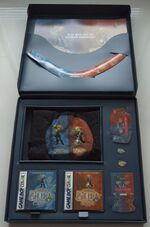
The limited edition adventure set
According to Encyclopedia, Oracle of Seasons takes place after A Link to the Past and Link's Awakening and before Oracle of Ages. The Japanese Encyclopedia notes that they feature a different Link from the prior games, while the English localization refers to all four games as featuring the same Link.
Prior to Encyclopedia, Oracle of Seasons and Oracle of Ages were situated between A Link to the Past and Link's Awakening, with all four games feature the same incarnation of Link.
Limited Editions[]
In North America, the first print of the game featured a foil effect on the tree's silhouette on the box and manual. In Europe, a limited edition was released. Limited to 500 copies, it included a copy of both Oracle games, a Boomerang, a shirt, two pins, and two skins for both the Game Boy Color and Game Boy Advance.
Speedrun Records[]
| Category | Runner | Time | Date |
|---|---|---|---|
| Any% | orima_r | 43m 25s | September 10, 2022 |
| All Essences | TGH | 1h 33m 9s | March 17, 2022 |
Listings[]
Characters[]
Bosses and mini-bosses[]
Enemies[]
Locations[]
Dungeons[]
Equipment and upgrades[]
Translations[]
Credits[]
Glitches[]
Reception[]
Sales[]
Oracle of Seasons was commercially successful, selling 3.96 million copies.[26]
Reviews[]
Oracle of Seasons was very well received by critics and received mostly positive reviews. Both games received 9.2/10 ratings at Gamespot,[27][28] and a 10 out of 10 rating of "Masterpiece" at IGN.[29][30] The games were often credited as being two of the top (if not the best) games for the Game Boy Color. In fact, Oracle of Seasons and Oracle of Ages were ranked by Nintendo Power as being the fourth and fifth best games for Game Boy/Game Boy Color, respectively.[31] Oracle of Seasons held a 91,37/100 score at GameRankings.[32]
Oracle of Seasons especially was praised for its vibrant graphics, due to the wide panoply of hues caused by the changing seasons. As such, it is considered to be the more graphically impressive of the two Oracle titles.[29] Gaming Target praised the gameplay aspect of the game, highlighting the use of its "new and fun" items and challenging dungeons.[33]
Fan Reception[]
Oracle of Seasons was equally praised by fans as well as critics. Both Oracle of Ages and Oracle of Seasons maintain a 9.1 user score at Gamespot.[27][28] However, at IGN, Seasons scored slightly higher at 9.2.[29] Oracle of Seasons is usually rated equal or higher than Oracle of Ages by critics and fans, which would appear to make it the more well-received of the two titles.
Oracle of Seasons & Oracle of Ages were both ranked at the #12 spot by WatchMojo as part of their "Every Major Legend of Zelda Game Ranked" video over on MojoPlays.[34]
Trivia[]
- In both the chapter book and the Oracle of Seasons manga by Akira Himekawa adaptations of Oracle of Seasons and Oracle of Ages games, Oracle of Seasons is the first game in the sequence. This is also true for the timeline as presented in Hyrule Historia.
Nomenclature[]
| Language | Name | Meaning | |
|---|---|---|---|
| Japanese | ゼルダの伝説 ふしぎの木の実 大地の章 (Zeruda no Densetsu Fushigi no Ki no Mi Daichi no Shō) | The Legend of Zelda: The Mystical Seed: Chapter of Earth | |
| ChineseSI | 塞尔达传说 不可思议的果实 大地之章 | ||
| ChineseTR | 薩爾達傳說 神秘果實 大地之章 | ||
| German | The Legend of Zelda: Oracle of Seasons | ||
Gallery[]
External links[]
References
- ↑ 1.0 1.1 Encyclopedia, Dark Horse Books, pg. 7
- ↑ 2.0 2.1 Nintendo (YouTube), Nintendo Direct 4.17.2013 - YouTube, YouTube, published 2013-04-17, retrieved 2013-04-19.
- ↑ 3.0 3.1 ニンテンドー3DS|ゼルダの伝説 ふしぎの木の実 時空の章|Nintendo, Nintendo, retrieved July 14, 2013.
- ↑ 4.0 4.1 Daniel Vuckovic, NINTENDO DOWNLOAD UPDATES: ORACLE OF ZELDA MEN, DENPA, Vooks, published May 30, 2013, retrieved May 6, 2016.
- ↑ 5.0 5.1 Virtual Console, Nintendo Korea, retrieved May 6, 2016.
- ↑ 6.0 6.1 NintendoUKofficial (YouTube), Nintendo 3DS Direct Presentation - 17.04.2013 - YouTube, YouTube, published 2013-04-17, retrieved 2013-04-19.
- ↑ 7.0 7.1 Nintendo (Official Website), July update! Two Game Boy games are now available for Nintendo Switch Online members, Nintendo, published 2023-07-26, retrieved 2023-07-27.
- ↑ Encyclopedia, Dark Horse Books, pg. 10
- ↑ "Nintendo is sending the Game Boy Color out with a bang by releasing not just one but two new Game Boy Zelda titles--Oracle of Seasons and Oracle of Ages..." — The Legend of Zelda: Oracle of Seasons Review, Gamespot.
- ↑ The Legend of Zelda: Phantom Hourglass — Prima Official Game Guide, Prima Games, pg. 5
- ↑ "The biggest difference between Seasons and Ages is that each focuses on a different aspect of the classic Zelda formula: Ages is puzzle-heavy while Seasons is action-oriented." — The Legend of Zelda: Oracle of Seasons Review, Gamespot.
- ↑ "The Oracle games originally started life out as a remake of the original NES Legend of Zelda. Yoshiki Okamoto of Capcom approached Miyamoto with the idea and, after much back and forth, got the go-ahead." — 25 Things You Didn't Know About The Legend of Zelda, 1UP.com.
- ↑ "The members of our team weren't agreeing over the direction that game development should take. I thought that we should produce a new version of the first Zelda game (released for the NES in the U.S.) for Game Boy Color. Then, if it went well, we could move on to the next stage (making a more ambitious game). But, my people wanted to skip that first phase and create their own Zelda game from the beginning." —Yoshiki Okamoto (The Legend of Zelda: Oracle of Seasons Interview Part I)
- ↑ "Mr. Miyamoto normally creates the game scenario (story and characters) after the initial game play is designed. If the action part of the game is solid, the scenario can be developed from there. We started by using the Capcom scenario creation company, Flag Ship, to create the scenario first. Then, we created maps and started developing the game. I don't believe that worked." —Yoshiki Okamoto (The Legend of Zelda: Oracle of Seasons Interview Part I)
- ↑ "Using that system, the team had to redo both the scenario and the maps several times to make all the elements fit." —Yoshiki Okamoto (The Legend of Zelda: Oracle of Seasons Interview Part I)
- ↑ "During that process, we realized that, since the Game Boy Color screen is narrower than a TV screen, the player must scroll the screen to the left and right to see the whole room. That created some difficulties in game play development. If you see a crack on a wall, you know that you need to use a bomb to break through. But, if you can't see the crack, because all of the walls in the room aren't visible at once, you could miss it. That led to more difficulty in developing the maps." —Yoshiki Okamoto (The Legend of Zelda: Oracle of Seasons Interview Part I)
- ↑ "[F]or the first little while I had left the team totally alone [without Miyamoto's help] because I figured they'd easily be able to do this much by themselves. So I left them alone, and for the first year we did nothing but lose lots of money. . . . So I came in, and I saw that nothing was working out, and I went up to Miyamoto and was like, 'Help me!'" —Yoshiki Okamoto (The Legend of Zelda: Oracle of Seasons Interview Part I)
- ↑ "When Okamoto ran into trouble attempting to remake the original Legend of Zelda for the Game Boy Color, Miyamoto came to the rescue with his idea for a trilogy called the Triforce series." — 25 Things You Didn't Know About The Legend of Zelda, .
- ↑ "One game was to focus on action (Chapter of Power), one was to focus on puzzles (Chapter of Wisdom), while the gameplay focus of the third (Chapter of Courage) was never officially announced." — The Legend of Zelda: The Third Oracle, IGN.
- ↑ "Later in development, this series of Zelda games and its three titles were given a new story concept the official name, The Legend of Zelda: Mystical Seed of Power, Mystical Seed of Courage, and Mystical Seed of Wisdom." — The Legend of Zelda: The Third Oracle, IGN.
- ↑ "Princess Zelda, keeper of the seasons, and the mysterious Triforce of Power have been kidnapped by the series' token villain, Ganon. Knowing this, Link embarks on a new adventure to once again free the princess from the clutches of the villainous thief. Ganon, now aware of Link's powers, quickly splits the Triforce of Power into eight pieces and hides them throughout the land. Even worse, Ganon has taken the Rod of the Seasons (a wand that controls the flow of time) and beamed it along with Hyrule Castle to an other-dimensional realm. Spring, summer, fall and winter in the land of Hyrule have fallen into complete disarray. With the help of the other-dimensional Ulra Tribe and the Mystery Tree that houses the spirits, Link must now venture through the world of Hyrule and find a way into the other dimension." — Hands-on Zelda, IGN.
- ↑ "Using the Rod of the Seasons, Link can change the seasons from spring, over summer and fall to winter. Naturally, the landscape also changes slightly with the seasons, making for many interesting puzzles." — Hands-on Zelda, IGN.
- ↑ "In addition to Link's usual range of attacks and moves, he can now meet up with a kangaroo named Rikki and ride in its pouch. The player then controls Rikki, who can jump the distance of one square at the time or perform punch attacks with his boxing gloves. Much like Yoshi in Super Mario World, Rikki comes in handy when Link can't overcome an obstacle with his own power. Another friendly character, the witch Mable, appears at certain moments in the game and sets off a number of events that drive the game forward." — Hands-on Zelda, IGN.
- ↑ "In 2000, the 3-game concept became too much for the platform and the limitations of the password system used for the games, so the team scaled the project back to just two games and restructured the password system and storyline. Mystical Seed of Power became Oracle of Seasons and Mystical Seed of Courage became Oracle of Ages, and both were released in 2001. The third chapter, Mystical Seed of Wisdom, was never finished..." — The Legend of Zelda: The Third Oracle, IGN.
- ↑ "Holodrum has four seasons: spring, summer, fall and winter. The world changes with the seasons. In spring, blast blooms can send you high in the air; summer reveals creek beds and lake bottoms. In fall, leaves open new paths and mushrooms are ready to be picked. In winter, snow blocks trails and lakes freeze." — N/A (Oracle of Seasons)
- ↑ RPGamer - Japandemonium - Xenogears vs. Tetris
- ↑ 27.0 27.1 Legend of Zelda: Oracle of Seasons Review - Gamespot
- ↑ 28.0 28.1 Legend of Zelda: Oracle of Ages Review - Gamespot
- ↑ 29.0 29.1 29.2 The Legend of Zelda: Oracle of Seasons Review - IGN
- ↑ The Legend of Zelda: Oracle of Ages Review - IGN
- ↑ Nintendo Power Magazine - Issue 231
- ↑ Game Boy Color, GameRankings (Archive).
- ↑ Gaming Target - The Legend of Zelda: Oracle of Seasons
- ↑ Alden, G. (2021). Every Major Legend of Zelda Game Ranked. YouTube. MojoPlays (WatchMojo). Retrieved July 27, 2023, from https://www.youtube.com/watch?v=9R7jh5pPBj8.
de-niwa:The Legend of Zelda: Oracle of Seasons




